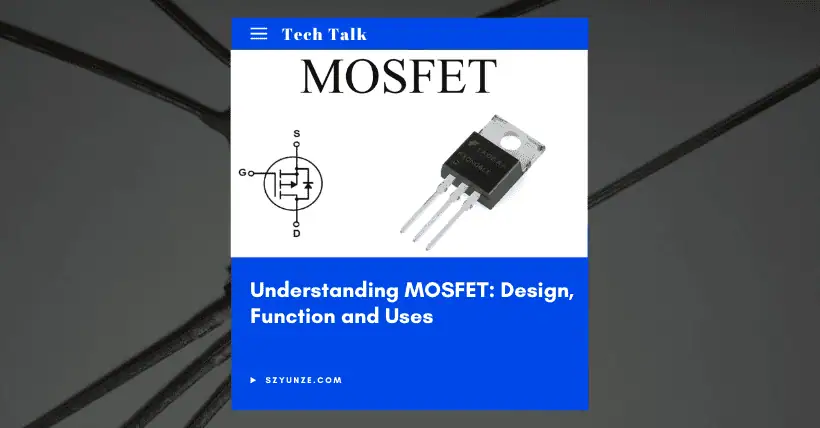01
Basic Concept for MOSFET
The full English name of MOSFET is “Metal-Oxide-Semiconductor Field-Effect Transistor.” In Chinese, it is called “金属-氧化物-半导体场效应晶体管.” It is a highly important semiconductor device in modern electronics, widely used in all kinds of electronic products—from everyday mobile phones and computers to industrial automation equipment.
This article is intended for general readers and will briefly introduce what a MOSFET is, how it works, its structure, types, and applications.
02
Basic Structure for MOSFET
The basic structure of a MOSFET includes four parts: the Source, the Drain, the Gate, and the Substrate. The source and drain are located at both ends of the semiconductor material, while the gate is separated from the semiconductor by an insulating oxide layer. The substrate serves as the foundation of the device, supporting the other parts.
03
Operating Principle for MOSFET
The working principle of a MOSFET is based on the surface electric field effect of semiconductors. Taking an N-channel MOSFET as an example: when the gate voltage is 0, the semiconductor region between the source and drain is in a high-resistance state, and the drain current is almost zero.
When the gate voltage rises above a certain threshold, an inversion layer (an N-type conductive channel) forms on the semiconductor surface beneath the gate. This conductive channel acts like a bridge that connects the source and drain, allowing electrons to flow from the source to the drain and generating a drain current.
MOSFETs operate in three regions: Cut-off, Linear, and Saturation. In the cut-off region, the gate voltage is below the threshold voltage, no conductive channel is formed, and the drain current is nearly zero—acting like an open switch.
In the linear region, the gate voltage is above the threshold voltage, and the drain-source voltage is relatively low. The drain current is approximately proportional to the drain-source voltage. In this region, the MOSFET can be used as a linear amplifier. In the saturation region, the gate voltage is above the threshold, and the drain-source voltage is high. The drain current is mostly determined by the gate voltage and hardly changes with drain-source voltage. Here, the MOSFET functions as a switch to control the circuit’s on/off states.
04
Main Types of MOSFETs
MOSFETs are mainly divided into N-channel and P-channel types. The conduction carriers in N-channel MOSFETs are electrons, while those in P-channel MOSFETs are holes. Though similar in operating principle, the two types differ in voltage polarity and current direction.
Depending on the conductive channel status at zero gate voltage, MOSFETs can also be classified into Enhancement-mode and Depletion-mode types. Enhancement-mode MOSFETs have no conductive channel at zero gate voltage and require a certain gate voltage to form a channel. Depletion-mode MOSFETs have a conductive channel at zero gate voltage and require a reverse gate voltage to eliminate the channel. In practice, enhancement-mode MOSFETs are more common due to their better switching performance and lower power consumption.
05
Main Applications
✅ Power Management
In the field of power management, MOSFETs are widely used in switching power supplies, linear voltage regulators, and battery chargers. In switching power supplies, MOSFETs typically function as switching devices. Through high-frequency switching operations, they convert input DC voltage into high-frequency AC voltage, which is then rectified and filtered to produce a stable DC output voltage. This working mode greatly improves power efficiency and reduces energy loss.
✅ Motor Control
MOSFETs also play a crucial role in motor control. They can regulate motor speed, direction, and start-stop behavior and are widely used in electric vehicles, industrial motors, and household appliances. For example, in electric vehicles, inverters composed of MOSFETs convert battery DC power into AC power to drive the motor.
✅ Signal Processing
In signal processing circuits, MOSFETs can be used as amplifiers, switches, and analog switches. As amplifiers, they can linearly amplify input signals and are commonly found in audio amplifiers and RF amplifiers. As switches, MOSFETs enable fast signal switching and are used in digital and communication circuits. As analog switches, they can select and transmit signals while maintaining signal integrity.
06
Conclusion
In summary, the MOSFET is an important, fundamental, and powerful electronic component. Its simple structure, excellent performance, and wide range of applications make it an indispensable part of various electronic devices. With ongoing technological advancements, MOSFET technology continues to improve—especially in areas such as integration, power consumption, and operating frequency—further driving innovation and development in electronics.
Related:

Disclaimer:
- This channel does not make any representations or warranties regarding the availability, accuracy, timeliness, effectiveness, or completeness of any information posted. It hereby disclaims any liability or consequences arising from the use of the information.
- This channel is non-commercial and non-profit. The re-posted content does not signify endorsement of its views or responsibility for its authenticity. It does not intend to constitute any other guidance. This channel is not liable for any inaccuracies or errors in the re-posted or published information, directly or indirectly.
- Some data, materials, text, images, etc., used in this channel are sourced from the internet, and all reposts are duly credited to their sources. If you discover any work that infringes on your intellectual property rights or personal legal interests, please contact us, and we will promptly modify or remove it.



